Friday, July 28th 2017

AMD Ryzen Threadripper Delidded - It's EPYC
Overclocker extraordinaire der8auer, who was one of the most vocal enthusiasts calling out for better VRM designs on Intel's X299 platform (and who worked with ASUS on redesigning the VRM cooling in its motherboards) has gone and done it: he delidded a Ryzen Threadripper CPU. And this delidding went on to deliver the goods: Ryzen Threadripper delidded is EPYC (pun intended.)
Instead of the expected MCM composed of two dies (with two CCXs of four cores per die, delivering the 16 cores we were expecting), Ryzen Threadripper is actually a much more interesting chip: it seems to be a full fledged EPYC chip, with four dies of eight cores. According to der8auer, when questioned, AMD confirmed that 16-core Threadripper 1950X CPUs are configured with two working eight core dies (four CCXs of four cores each), while the other eight-core dies are disabled by AMD.A very, very interesting question here is whether these are actually defective or just disabled by AMD, which is something the company is naturally mum about. With AMD's history of core unlocking, and the fact that Zen-based CPUs have high yields, we can certainly hope (maybe even expect) that not all disabled cores are non-functional, and that AMD had to disable some of them so as to achieve their SKU core-count. Whether or not those will be unlockable, though, is anybody's guess. Der8auer also found that AMD Threadripper dies are gold plated on the inside, so as to improve conditions and adherence of the indium solder AMD used (some users might say that while Intel uses cheap TIM on their HEDT, X299 CPUs, AMD even sells these with gold inside.) This fact naturally also opens the question of future platform scalability - AMD can certainly decide to just up available maximum core-count on their Threadripper line of CPUs (we still have at least 4 model numbers above the 1950X, an potentially more.)Check Der8auer's delidding video on YouTube below.
Source:
Der8auer's YouTube Channel
Instead of the expected MCM composed of two dies (with two CCXs of four cores per die, delivering the 16 cores we were expecting), Ryzen Threadripper is actually a much more interesting chip: it seems to be a full fledged EPYC chip, with four dies of eight cores. According to der8auer, when questioned, AMD confirmed that 16-core Threadripper 1950X CPUs are configured with two working eight core dies (four CCXs of four cores each), while the other eight-core dies are disabled by AMD.A very, very interesting question here is whether these are actually defective or just disabled by AMD, which is something the company is naturally mum about. With AMD's history of core unlocking, and the fact that Zen-based CPUs have high yields, we can certainly hope (maybe even expect) that not all disabled cores are non-functional, and that AMD had to disable some of them so as to achieve their SKU core-count. Whether or not those will be unlockable, though, is anybody's guess. Der8auer also found that AMD Threadripper dies are gold plated on the inside, so as to improve conditions and adherence of the indium solder AMD used (some users might say that while Intel uses cheap TIM on their HEDT, X299 CPUs, AMD even sells these with gold inside.) This fact naturally also opens the question of future platform scalability - AMD can certainly decide to just up available maximum core-count on their Threadripper line of CPUs (we still have at least 4 model numbers above the 1950X, an potentially more.)Check Der8auer's delidding video on YouTube below.
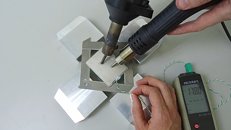

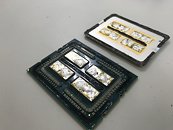

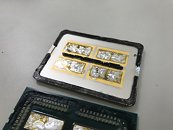
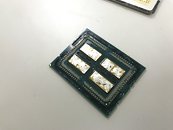
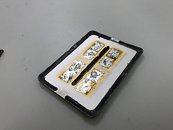
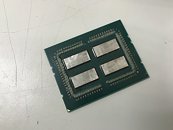
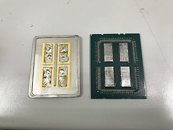
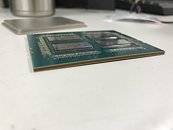
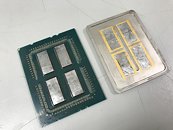
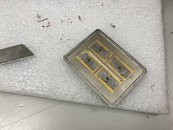
55 Comments on AMD Ryzen Threadripper Delidded - It's EPYC
Maybe one day we can have a 32core CPU for our threadripper machines?
This behavior of indium-based solders is properly documented, too, so while some see it as a boon, I see it a weakness in AMD's products, because, you know, I like science, not hype.
Most of Asus X299 boards on the market have the original heatsink, same with the other brands.
But this is really fun. Intel engineers will have a hard time to find a way to create an 18 core model for a socket that was designed for 10 core models, without coming out with a laughable base frequency. Only to see AMD coming out latter with 24 or 32 cores models, probably at more reasonable base frequencies.
In the end it seems that financial problems give AMD an advantage here. With no server market, so nothing to lose, and huge financial problems, that restrict them from creating multiple product lines, they are able to give a few but really solid products to their customers.
People who don't even own Skylake-X make the most noise about how bad it is.
So der8auer who is working with ASUS convinced said ASUS to change heatsink on APEX mobo which is not even on the market and barely anyone will buy it except those who wish to bench on LN2 and then this heatsink won't matter much anyway.
I'd bet money that AMD allows these to be unlocked. Very clever AMD, very clever. ;)
imgur.com/a/gsUrv
It becomes a problem with extreme temperature shifts, like liquid nitrogen T to ambient T over a set amount of cooling-warming cycles.
Indium is a costly material, if it wasn't performing for the Au-In-Si interface at normal T it will not be used at all.
That photo of the threadripper dies exposed shows something around 8-12 dollars of indium.
It makes business sense, though as I consumer I'll always chose what's best for me & consider the product that provides better VFM, as compared to the other competitor.The 6950x or any other BDWE btw was that a rhetorical question?
Ivy was the first mainstream CPU, in a long time, that wasn't soldered, SKLX being the first HEDT which went the Ivy way. Basically there's nothing out there that suggests that solder goes kaput first, as compared to TIM, having said that we have TR & SKLX which will prove this theory one way or another.
think about it, one slice silicon to rule them all market segment from server, HEDT, performance, mainstream, all the way down to potato-grade CPU.
meanwhile Intel need to spend R&D and new design of silicons for each segmentation.
There are some 10yo CPUs there and I have a E8400 at home still going strong, Buddy of mine was using a Q8400 up until a year ago without any issues (16h of gaming every day).
I just wanted to confirm for myself that solder has no issues in the long run. Because I'm more of a facts kinda guy than empty science.